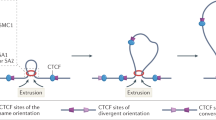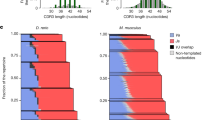Abstract
During B cell and T cell development, the lymphoid-specific proteins RAG-1 and RAG-2 act together to initiate the assembly of antigen receptor genes through a series of site-specific somatic DNA rearrangements that are collectively called variable-diversity-joining (V(D)J) recombination. In the past 20 years, a great deal has been learned about the enzymatic activities of the RAG-1–RAG-2 complex. Recent studies have identified several new and exciting regulatory functions of the RAG-1–RAG-2 complex. Here we discuss some of these functions and suggest that the RAG-1–RAG-2 complex nucleates a specialized subnuclear compartment that we call the 'V(D)J recombination factory'.
This is a preview of subscription content, access via your institution
Access options
Subscribe to this journal
Receive 12 print issues and online access
$209.00 per year
only $17.42 per issue
Buy this article
- Purchase on Springer Link
- Instant access to full article PDF
Prices may be subject to local taxes which are calculated during checkout


Similar content being viewed by others
References
Liu, Y., Subrahmanyam, R., Chakraborty, T., Sen, R. & Desiderio, S. A plant homeodomain in RAG-2 that binds Hypermethylated lysine 4 of histone H3 is necessary for efficient antigen-receptor-gene rearrangement. Immunity 27, 561–571 (2007).
Matthews, A.G. et al. RAG2 PHD finger couples histone H3 lysine 4 trimethylation with V(D)J recombination. Nature 450, 1106–1110 (2007).
Perkins, E.J., Kee, B.L. & Ramsden, D.A. Histone 3 lysine 4 methylation during the pre-B to immature B-cell transition. Nucleic Acids Res. 32, 1942–1947 (2004).
Ramon-Maiques, S. et al. The plant homeodomain finger of RAG2 recognizes histone H3 methylated at both lysine-4 and arginine-2. Proc. Natl. Acad. Sci. USA 104, 18993–18998 (2007).
Golding, A., Chandler, S., Ballestar, E., Wolffe, A.P. & Schlissel, M.S. Nucleosome structure completely inhibits in vitro cleavage by the V(D)J recombinase. EMBO J. 18, 3712–3723 (1999).
Baumann, M., Mamais, A., McBlane, F., Xiao, H. & Boyes, J. Regulation of V(D)J recombination by nucleosome positioning at recombination signal sequences. EMBO J. 22, 5197–5207 (2003).
Kwon, J., Imbalzano, A.N., Matthews, A. & Oettinger, M.A. Accessibility of nucleosomal DNA to V(D)J cleavage is modulated by RSS positioning and HMG1. Mol. Cell 2, 829–839 (1998).
Kwon, J., Morshead, K.B., Guyon, J.R., Kingston, R.E. & Oettinger, M.A. Histone acetylation and hSWI/SNF remodeling act in concert to stimulate V(D)J cleavage of nucleosomal DNA. Mol. Cell 6, 1037–1048 (2000).
Patenge, N., Elkin, S.K. & Oettinger, M.A. ATP-dependent remodeling by SWI/SNF and ISWI proteins stimulates V(D)J cleavage of 5 S arrays. J. Biol. Chem. 279, 35360–35367 (2004).
Alessandrini, A. & Desiderio, S.V. Coordination of immunoglobulin DJH transcription and D-to-JH rearrangement by promoter-enhancer approximation. Mol. Cell. Biol. 11, 2096–2107 (1991).
Bolland, D.J. et al. Antisense intergenic transcription precedes Igh D-to-J recombination and is controlled by the intronic enhancer Emu. Mol. Cell. Biol. 27, 5523–5533 (2007).
Chakraborty, T. et al. Repeat organization and epigenetic regulation of the DH-Cmu domain of the immunoglobulin heavy-chain gene locus. Mol. Cell 27, 842–850 (2007).
Elkin, S.K. et al. A PHD finger motif in the C terminus of RAG2 modulates recombination activity. J. Biol. Chem. 280, 28701–28710 (2005).
Matthews, A.G., Elkin, S.K. & Oettinger, M.A. Ordered DNA release and target capture in RAG transposition. EMBO J. 23, 1198–1206 (2004).
Elkin, S.K., Matthews, A.G. & Oettinger, M.A. The C-terminal portion of RAG2 protects against transposition in vitro. EMBO J. 22, 1931–1938 (2003).
Tsai, C.L. & Schatz, D.G. Regulation of RAG1–RAG2-mediated transposition by GTP and the C-terminal region of RAG2. EMBO J. 22, 1922–1930 (2003).
Swanson, P.C., Volkmer, D. & Wang, L. Full-length RAG-2, and not full-length RAG-1, specifically suppresses RAG-mediated transposition but not hybrid joint formation or disintegration. J. Biol. Chem. 279, 4034–4044 (2004).
Lin, W.C. & Desiderio, S. Cell cycle regulation of V(D)J recombination-activating protein RAG-2. Proc. Natl. Acad. Sci. USA 91, 2733–2737 (1994).
Akamatsu, Y. et al. Deletion of the RAG2 C terminus leads to impaired lymphoid development in mice. Proc. Natl. Acad. Sci. USA 100, 1209–1214 (2003).
Liang, H.E. et al. The “dispensable” portion of RAG2 is necessary for efficient V-to-DJ rearrangement during B and T cell development. Immunity 17, 639–651 (2002).
Kirch, S.A., Rathbun, G.A. & Oettinger, M.A. Dual role of RAG2 in V(D)J recombination: catalysis and regulation of ordered Ig gene assembly. EMBO J. 17, 4881–4886 (1998).
Li, Z., Dordai, D.I., Lee, J. & Desiderio, S. A conserved degradation signal regulates RAG-2 accumulation during cell division and links V(D)J recombination to the cell cycle. Immunity 5, 575–589 (1996).
Jurutka, P.W. et al. The polymorphic N terminus in human vitamin D receptor isoforms influences transcriptional activity by modulating interaction with transcription factor IIB. Mol. Endocrinol. 14, 401–420 (2000).
Hubbard, S.R., Mohammadi, M. & Schlessinger, J. Autoregulatory mechanisms in protein-tyrosine kinases. J. Biol. Chem. 273, 11987–11990 (1998).
Kosak, S.T. et al. Subnuclear compartmentalization of immunoglobulin loci during lymphocyte development. Science 296, 158–162 (2002).
Sayegh, C.E., Jhunjhunwala, S., Riblet, R. & Murre, C. Visualization of looping involving the immunoglobulin heavy-chain locus in developing B cells. Genes Dev. 19, 322–327 (2005).
Jhunjhunwala, S. et al. The 3D structure of the immunoglobulin heavy-chain locus: implications for long-range genomic interactions. Cell 133, 265–279 (2008).
Skok, J.A. et al. Reversible contraction by looping of the Tcra and Tcrb loci in rearranging thymocytes. Nat. Immunol. 8, 378–387 (2007).
Fuxa, M. et al. Pax5 induces V-to-DJ rearrangements and locus contraction of the immunoglobulin heavy-chain gene. Genes Dev. 18, 411–422 (2004).
Liu, H. et al. Yin Yang 1 is a critical regulator of B-cell development. Genes Dev. 21, 1179–1189 (2007).
Reynaud, D. et al. Regulation of B cell fate commitment and immunoglobulin heavy-chain gene rearrangements by Ikaros. Nat. Immunol. 9, 927–936 (2008).
Hewitt, S.L. et al. RAG-1 and ATM coordinate monoallelic recombination and nuclear positioning of immunoglobulin loci. Nat. Immunol. 10, 655–664 (2009).
Difilippantonio, M.J., McMahan, C.J., Eastman, Q.M., Spanopoulou, E. & Schatz, D.G. RAG1 mediates signal sequence recognition and recruitment of RAG2 in V(D)J recombination. Cell 87, 253–262 (1996).
Huye, L.E., Purugganan, M.M., Jiang, M.M. & Roth, D.B. Mutational analysis of all conserved basic amino acids in RAG-1 reveals catalytic, step arrest, and joining-deficient mutants in the V(D)J recombinase. Mol. Cell. Biol. 22, 3460–3473 (2002).
Spanopoulou, E. et al. The homeodomain region of Rag-1 reveals the parallel mechanisms of bacterial and V(D)J recombination. Cell 87, 263–276 (1996).
Tsai, C.L., Drejer, A.H. & Schatz, D.G. Evidence of a critical architectural function for the RAG proteins in end processing, protection, and joining in V(D)J recombination. Genes Dev. 16, 1934–1949 (2002).
Yarnell Schultz, H., Landree, M.A., Qiu, J.X., Kale, S.B. & Roth, D.B. Joining-deficient RAG1 mutants block V(D)J recombination in vivo and hairpin opening in vitro. Mol. Cell 7, 65–75 (2001).
Qiu, J.X., Kale, S.B., Yarnell Schultz, H. & Roth, D.B. Separation-of-function mutants reveal critical roles for RAG2 in both the cleavage and joining steps of V(D)J recombination. Mol. Cell 7, 77–87 (2001).
Corneo, B. et al. Rag mutations reveal robust alternative end joining. Nature 449, 483–486 (2007).
Lee, G.S., Neiditch, M.B., Salus, S.S. & Roth, D.B. RAG proteins shepherd double-strand breaks to a specific pathway, suppressing error-prone repair, but RAG nicking initiates homologous recombination. Cell 117, 171–184 (2004).
Raval, P., Kriatchko, A.N., Kumar, S. & Swanson, P.C. Evidence for Ku70/Ku80 association with full-length RAG1. Nucleic Acids Res. 36, 2060–2072 (2008).
Hewitt, S.L. et al. RAG1 and ATM coordinate mono-allelic recombination and nuclear positioning of immunoglobulin loci. Nat. Immunol. 10, 655–664 (2009).
Osipovich, O. et al. Essential function for SWI-SNF chromatin-remodeling complexes in the promoter-directed assembly of Tcrb genes. Nat. Immunol. 8, 809–816 (2007).
Morshead, K.B., Ciccone, D.N., Taverna, S.D., Allis, C.D. & Oettinger, M.A. Antigen receptor loci poised for V(D)J rearrangement are broadly associated with BRG1 and flanked by peaks of histone H3 dimethylated at lysine 4. Proc. Natl. Acad. Sci. USA 100, 11577–11582 (2003).
Johnson, K., Angelin-Duclos, C., Park, S. & Calame, K.L. Changes in histone acetylation are associated with differences in accessibility of V(H) gene segments to V-DJ recombination during B-cell ontogeny and development. Mol. Cell. Biol. 23, 2438–2450 (2003).
McMurry, M.T. & Krangel, M.S. A role for histone acetylation in the developmental regulation of VDJ recombination. Science 287, 495–498 (2000).
McBlane, F. & Boyes, J. Stimulation of V(D)J recombination by histone acetylation. Curr. Biol. 10, 483–486 (2000).
Lewis, S.M., Agard, E., Suh, S. & Czyzyk, L. Cryptic signals and the fidelity of V(D)J joining. Mol. Cell. Biol. 17, 3125–3136 (1997).
Marculescu, R., Le, T., Simon, P., Jaeger, U. & Nadel, B. V(D)J-mediated translocations in lymphoid neoplasms: a functional assessment of genomic instability by cryptic sites. J. Exp. Med. 195, 85–98 (2002).
Raghavan, S.C., Swanson, P.C., Wu, X., Hsieh, C.L. & Lieber, M.R. A non-B-DNA structure at the Bcl-2 major breakpoint region is cleaved by the RAG complex. Nature 428, 88–93 (2004).
Reddy, Y.V., Perkins, E.J. & Ramsden, D.A. Genomic instability due to V(D)J recombination-associated transposition. Genes Dev. 20, 1575–1582 (2006).
Chatterji, M., Tsai, C.L. & Schatz, D.G. Mobilization of RAG-generated signal ends by transposition and insertion in vivo. Mol. Cell. Biol. 26, 1558–1568 (2006).
Messier, T.L., O'Neill, J.P., Hou, S.M., Nicklas, J.A. & Finette, B.A. In vivo transposition mediated by V(D)J recombinase in human T lymphocytes. EMBO J. 22, 1381–1388 (2003).
Marculescu, R. et al. Recombinase, chromosomal translocations and lymphoid neoplasia: targeting mistakes and repair failures. DNA Repair (Amst.) 5, 1246–1258 (2006).
Acknowledgements
We apologize to those whose work we were unable to cite because of space limitations. Supported by the US National Institutes of Health (M.A.O.) and the Damon Runyon Cancer Research Foundation (DRG-1981-08 to A.G.W.M.).
Author information
Authors and Affiliations
Rights and permissions
About this article
Cite this article
Matthews, A., Oettinger, M. RAG: a recombinase diversified. Nat Immunol 10, 817–821 (2009). https://doi.org/10.1038/ni.1776
Published:
Issue Date:
DOI: https://doi.org/10.1038/ni.1776
This article is cited by
-
Genome organization in immune cells: unique challenges
Nature Reviews Immunology (2019)
-
Recombination-activating gene 1 and 2 (RAG1 and RAG2) in flounder (Paralichthys olivaceus)
Journal of Biosciences (2014)
-
Role of tissue-specific AT-rich DNA sequence-binding proteins in lymphocyte differentiation
International Journal of Hematology (2014)
-
Functional characterization of an active Rag-like transposase
Nature Structural & Molecular Biology (2012)
-
Recombination centres and the orchestration of V(D)J recombination
Nature Reviews Immunology (2011)



